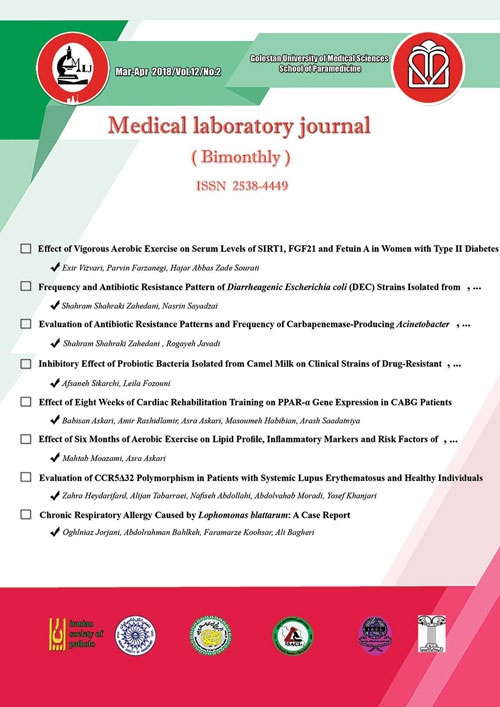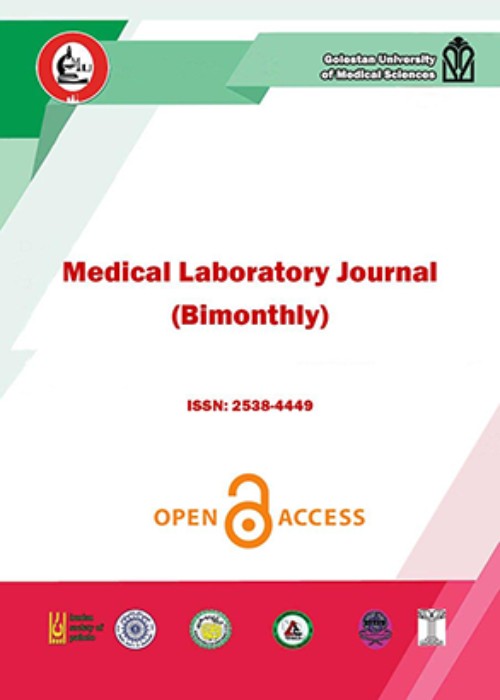فهرست مطالب

Medical Laboratory Journal
Volume:12 Issue: 2, Mar-Apr 2018
- تاریخ انتشار: 1397/02/22
- تعداد عناوین: 8
-
-
Pages 1-6Background And ObjectivesSirtuin (SIRT), Fibroblast Growth Factor21 (FGF21) and Fetuin A are proteins that cause a wide range of metabolic disorders such as type 2 diabetes mellitus (T2DM). On the other hand, regular physical activity is known to play a key role in prevention and management of T2DM. Thus, this study investigated the effect of vigorous aerobic exercise on serum levels of metabolic parameters including SIRT1, FGF21 and Fetuin A in women with T2DM.MethodsThe study was performed on 28 randomly selected women with T2DM who were divided into an exercise group and a control group. The training intervention consisted eight weeks of vigorous aerobic exercise (three times a week at 70-80% of maximum heart rate). The serum levels of SIRT1, FGF21 and Fetuin A were evaluated before the first session and 48 hours after the last session. Paired sample t-test and independent t-test were used to analyze within and between group differences, respectively. All statistical analyses were performed in SPSS (version 19) at significance of 0.05.ResultsThe eight-week aerobic training caused a significant reduction in body weight, body mass index, insulin resistance, low-density lipoprotein, fasting blood sugar, triglycerides and Fetuin A of women with T2DM. In addition, it caused a significant increase in SIRT1 and FGF21 levels. There was no significant difference in the level of high-density lipoprotein and cholesterol between the two groups.ConclusionAs a non-pharmacological therapy, regular aerobic exercise might improve the metabolic parameters, SIRT1, FGF21, and Fetuin A in women with T2DM.Keywords: Diabetes Mellitus Type 2, SIRT1, FGF21, Fetuin A, Exercise
-
Pages 7-12Background And ObjectivesDiarrheagenic Escherichia coli (DEC) pathotypes are important causes of diarrhea among children in developing countries. The objective of this study was to determine the frequency and antibiotic resistance pattern of DEC pathotypes in children aged less than 10 years.
MethodsThis cross-sectional study was done on 300 E. coli strains isolated from diarrheic stool samples of children aged less than 10 years who were admitted to hospitals and central laboratory in Zahedan, between July and October 2016. DEC pathotypes were identified by standard biochemical testing and phenotypic testing using polyvalent antiserums. Antibiotic resistant pattern of these strains was evaluated against 11 different antibiotics by the agar disk diffusion method according to the Clinical and Laboratory Standards Institute guidelines.
ResultsOf the 300 E. coli isolates, 89 (29.6%) were found positive for DEC using polyvalent antiserums. In this study, 35 cases (39.3%) reacted with antiserum 1, 21 cases (25.8%) reacted with the antiserum 2, and 31 cases (34.8%) reacted with antiserum 3. The highest rate of resistance was observed against ampicillin (94.8%), tetracycline (87.2%), and co-trimoxazole (70.5%). In addition, the lowest rate of resistance was related to imipenem (1%) and ciprofloxacin (8.9%).
ConclusionDEC pathotypes are the important causes of diarrhea among children admitted to hospitals of Zahedan. Considering the high rate of antibiotic resistance among these pathotypes in this region, prescription of antibiotics should be based on accurate detection of these strains.Keywords: Escherichia coli, Child, Antibiotic Resistance -
Pages 13-19Background And ObjectivesAcinetobacter baumannii is an opportunistic pathogen associated with nosocomial infections. Treatment of infections caused by this bacterium has become challenging due to increasing rate of resistance to a wide range of antibiotics such as carbapenems. One of the main mechanisms of resistance to carbapenems is the production of carbapenemase. The objective of this study was to evaluate antibiotic resistance patterns and frequency of carbapenemase-producing A. baumannii strains using the CarbAcineto NP Test.
MethodsIn this descriptive cross-sectional study, 130 A. baumannii isolates were collected from clinical specimens of teaching hospitals in Zahedan in 2016. After determining the antibiotic resistance patterns, all A. baumannii isolates were examined using the phenotypic method of CarbAcineto NP test to evaluate production of carbapenemase enzymes.
ResultsBased on the antibiogram results, more than 90% of the isolates were resistant to the antibiotics tested in this study. However, the lowest rate of resistance was observed against colistin, minocycline, tigecycline and doxycycline, respectively. Based on the results of the CarbAcineto NP test, 96% of carbapenem-resistant strains were positive for the production of carbapenemases.
ConclusionDue to the high resistance of A. baumannii to carbapenems, they are not currently suitable for the treatment of infections caused by this bacterium. However, since most carbapenem-resistant strains are susceptible to colistin, minocycline, tigecycline, and doxycycline, these antibiotics or their combination are recommended for the treatment of the infections caused by the resistant strains. Rapid identification of carbapenemase-producing bacteria using efficient methods such as CarbAcineto NP test is essential to prevent their spread, particularly in hospitals.Keywords: Acinetobacter baumannii, Carbapenemase, CarbAcinetoNP Test -
Pages 20-26Background And ObjectivesHelicobacter pylori is the most common cause of gastritis and ulcer worldwide. Treatment of such infections may lead to failure due to drug resistance. This study aimed to investigate the antimicrobial effects of bacteria present in camel milk on the growth of drug-resistant clinical isolates of H. pylori.
MethodsIn this cross-sectional study, biopsy samples from 75 patients with digestive symptoms were transferred to laboratory in transport medium containing homogeneous compounds. In order to isolate H. pylori, urease-positive biopsies were promptly cultured in brucella agar enriched with defibrinated sheep blood and fetal calf serum. Disk diffusion agar test was used to evaluate antibiotic susceptibility and agar well diffusion method was applied to study the antagonistic effect of probiotics isolated from camel milk on the H. pylori isolates.
ResultsThe frequency of H. pylori isolates was 42.7%. The highest rate of resistance was observed against metronidazole (56.3%). In addition, the rate of resistant to amoxicillin, ciprofloxacin, and clarithromycin and tetracycline was 31.3%, 18.8%, 15.6%, respectively. Lactobacillus plantarum (59.3%) was more frequent than other Lactobacillus species. L. plantarum, Lactobacillus fermentum and Lactobacillus casei showed favorable inhibitory effects against the H. pylori isolates, but L. plantarum (with inhibition zone diameter of 20.3 mm) showed the highest inhibitory effect.
ConclusionConsidering the increasing rate of drug resistance and the inhibitory effect of probiotics isolated from milk, health providers recommend that promoting consumption of probiotic food seems beneficial for the general population and those suffering from gastrointestinal disorders.Keywords: Helicobacter pylori, Drug resistance, Camel, milk, Probiotics -
Pages 27-31Background And ObjectivesCardiovascular disease is the leading cause of death worldwide. This study examined the effects of cardiac rehabilitation exercise on lipid profile and expression of peroxisome proliferator-activated receptor alpha (PPAR-α) gene in patients who underwent coronary artery bypass grafting.
MethodsIn this quasi-experimental study, after screening, patients who underwent coronary artery bypass grafting (CABG) were randomly divided into an experimental group (n=12) and a control group (n=12). After the surgery and discharge from hospital, the experimental group performed rehabilitation exercise for two months, while the control group did not perform any exercise after discharge from the hospital and the initial phase of rehabilitation. Fasting blood samples were collected before and after the last training session to evaluate biochemical variables and PPAR-α gene expression of lymphocytes. PPAR-α expression level was assessed by qRT-PCR. Statistical analysis was done in the SPSS software (version 20) using repeated measures.
ResultsIn the follow-up after the two-month cardiac rehabilitation exercise, the PPAR-α gene was significantly overexpressed and plasma HDL levels increased significantly in the training group compared with the control group (P0.05).
ConclusionThe results indicate that the protocols carried out in the study could be utilized for improving HDL levels and cardiovascular function in CABG patients.Keywords: Cardiac Rehabilitation, Gene Expression, PPAR-? -
Pages 32-37Background And ObjectivesThe aim of this study was to investigate the effects of six months of aerobic exercise on lipid profile, inflammatory markers, and risk factors of cardiovascular disease in middle-aged obese women.
MethodsFifteen obese woman (age range: 35 to 45 years) with BMI of ≥30 Kg/m2 were enrolled via purposeful and convenience sampling. The participants were randomly divided into training (n=10) and control (n=5) groups. Blood samples (7 ml) were taken from all participants before the first training session and after the last training session. The women performed 60 minutes of aerobic exercise at 55-65% of heart rate reserve, three sessions a week, for six months. Data was analyzed using independent and paired t-tests and Mann-Whitney U and Wilcoxon tests at significance of 0.05.
ResultsAfter the six-month aerobic exercise, C-reactive protein, low-density lipoprotein, triglycerides, total cholesterol and high-density lipoprotein/total cholesterol decreased significantly. The exercise intervention also caused a significant increase in the concentrations of high-density lipoprotein and apolipoprotein A.
ConclusionAerobic exercise can reduce the level of inflammatory markers associated with risk of cardiovascular disease and atherosclerosis.Keywords: Lipid profile, Inflammatory markers, Obese women, Apolipoprotein, Aerobic exercise -
Pages 38-43Background And ObjectivesC-C chemokine receptor type 5 (CCR5) is a chemokine receptor expressed at high levels on the surface of T-cells. A 32-bp deletion in the coding region of the CCR5 (CCR5Δ32) leads to production of an incomplete protein that is not expressed on the cell surface. CCR5Δ32 may be involved in development of autoimmune disease, such as systemic lupus erythematosus. We investigated frequency of the CCR5Δ32 polymorphism in SLE patients and healthy controls, and evaluated the relationship between the CCR5Δ32 polymorphism and susceptibility to SLE in Golestan Province, Iran.
MethodsWhole blood samples were taken from 80 SLE patients admitted to Shahid Sayyad Shirazi hospital and 80 healthy controls (from a blood bank) in the Golestan Province, in 2016. Baseline clinical and laboratorial characteristics were evaluated regarding the CCR5Δ32 genotypes. The CCR5Δ32 polymorphism was determined from genomic DNA by polymerase chain reaction.
ResultGenotype frequencies of both groups were in the Hardy-Weinberg equilibrium. The frequencies of the CCR5 and the CCR5Δ32 alleles were 98.13% and 1.88% among the patients, and 98.75% and 1.25% among the controls, respectively. Homozygote CCR5Δ32 was not observed in the subjects. The frequency of heterozygous Δ32 was 3.8% and 2.5% among the SLE patients and controls, respectively (P-value>0.05). There was no significant association between the CCR5 status and clinical signs of SLE (P>0.05).
ConclusionOur data suggest that the CCR5Δ32 polymorphism has no correlation with SLE in our study population. In addition, the frequency of the Δ32 polymorphism in SLE patients and controls does not follow the Hardy-Weinberg equilibriumKeywords: CCR5, Homozygote CCR5?32, Heterozygote CCR5?32, CCR5?32 allele, SLE -
Pages 44-46Background And ObjectiveLophomonas blattarum is a multi-flagellate protozoan that is commensal in hindgut of cockroaches and other insects. The protozoan can cause respiratory infection in humans. Most cases of the infections with this protozoan have been reported in China. Here, we present a case with chronic respiratory allergy caused by L. blattarum in Golestan province, Iran.
Case Description: The case was a 37-year-old male with history of respiratory conditions and he was immunocompetent. An athlete. L. blattarum was detected in direct smear examination of sputum,
ConclusionSince we found respiratory infection in an immunocompetent individual who was also an athlete, it is necessary to study this parasite and its life cycle and transmission methods. It is also suggested to consider L. blattarum infection and treatment with metronidazole in cases of chronic allergies, especially those that do not respond to treatment.Keywords: Lophomonas blattarum, Respiratory Allergies, Iran


